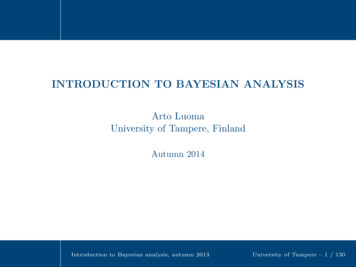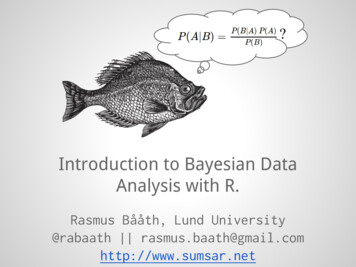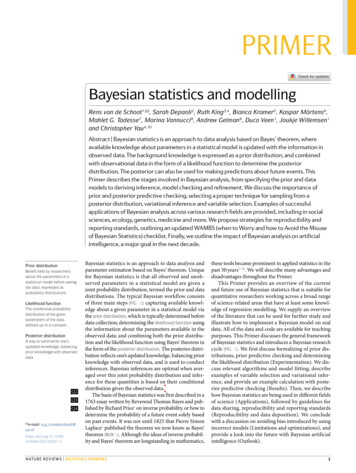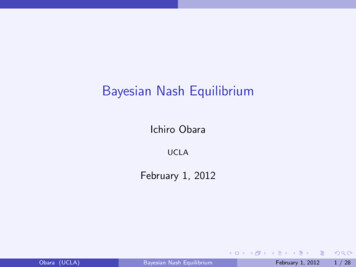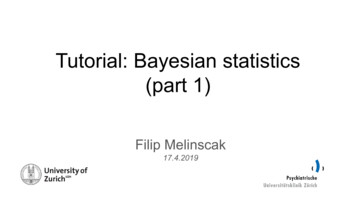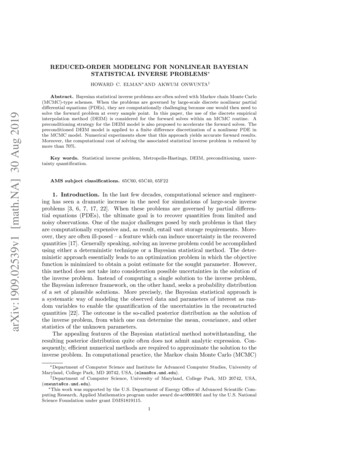
Transcription
Practical Multi-fidelity Bayesian Optimization for Hyperparameter TuningJian WuOperations Research& Information Eng.Cornell UniversityIthaca, NY 14850Saul Toscano-PalmerinOperations Research& Information Eng.Cornell UniversityIthaca, NY 14850AbstractBayesian optimization is popular for optimizing time-consuming black-box objectives.Nonetheless, for hyperparameter tuning in deepneural networks, the time required to evaluate the validation error for even a few hyperparameter settings remains a bottleneck.Multi-fidelity optimization promises relief using cheaper proxies to such objectives — forexample, validation error for a network trainedusing a subset of the training points or feweriterations than required for convergence. Wepropose a highly flexible and practical approachto multi-fidelity Bayesian optimization, focusedon efficiently optimizing hyperparameters foriteratively trained supervised learning models.We introduce a new acquisition function, thetrace-aware knowledge-gradient, which efficiently leverages both multiple continuous fidelity controls and trace observations — values of the objective at a sequence of fidelities,available when varying fidelity using trainingiterations. We provide a provably convergentmethod for optimizing our acquisition functionand show it outperforms state-of-the-art alternatives for hyperparameter tuning of deep neuralnetworks and large-scale kernel learning.1INTRODUCTIONIn hyperparameter tuning of machine learning models, weseek to find hyperparameters x in some set A Rd tominimize the validation error f (x), i.e., to solvemin f (x)x A(1.1)Evaluating f (x) can take substantial time and computational power (Bergstra and Bengio, 2012) and mayPeter I. FrazierOperations Research& Information Eng.Cornell UniversityIthaca, NY 14850Andrew Gordon WilsonCourant Instituteof Mathematical SciencesNew York UniversityNew York, NY 10003not provide gradient evaluations. Bayesian optimization,which requires relatively few function evaluations, provides a compelling approach to such optimization problems (Jones et al., 1998; Snoek et al., 2012).As the computational expense of training and testing amodern deep neural network for a single set of hyperparameters has grown, researchers have sought to supplantsome evaluations of f (x) with computationally inexpensive low-fidelity approximations. Conceputally, an algorithm can use low-fidelity evaluations to quickly identifya smaller set of promising hyperparameters, and then laterfocus more expensive high-fidelity evaluations within thisset to refine its estimates.Pioneering multi-fidelity approaches focused on hyperparameter tuning for deep neural networks include theBayesian optimization methods FaBOLAS (Klein et al.,2017a, 2015), Freeze-Thaw Bayesian Optimization (Swersky et al., 2014), BOHB (Falkner et al., 2018), BOCA(Kandasamy et al., 2017), predictive entropy search fora single continuous fidelity (McLeod et al., 2017), earlystopping SMAC (Domhan et al., 2015), and the banditmethod Hyperband (Li et al., 2018). This work buildson earlier multi-fidelity and multi-information source optimization approaches (Huang et al., 2006; Lam et al.,2015; Poloczek et al., 2017) not focused on hyperparameter tuning.Validation error approximations used by these methodsperform the same training and testing steps as in standardBayesian optimization but control fidelity by reducingtraining iterations, training data points, or validation datapoints. For tuning iteratively trained machine learningmodels like deep neural networks, these approximationspresent unique opportunities almost entirely unexploredin the multifidelity literature, even within the portion focused on hyperparameter tuning. First, we observe a fulltrace of performance with respect to training iterationsrather than just a single performance value at the chosenfidelity: while training with s iterations, we also calcu-
late as a byproduct a sequence of models fitted with fewertraining iterations. Second, by caching state after completing s iterations, we can significantly reduce computationtime when later training with s0 s iterations. This allows quickly evaluating low-fidelity approximations tothe validation error using few training iterations for manyhyperparameter settings, then later obtaining more accurate observations for the most promising ones by addingiterations. Third, we may simultaneously alter fidelityalong several continuous dimensions (iterations, trainingdata, validation data), rather than modifying one continuous fidelity control or choosing from among a discrete setof ambiguously related fidelities.The knowledge-gradient (KG) approach to acquisitionfunction design (Frazier et al., 2009; Frazier, 2018) iswell-suited to taking advantage of these opportunitiesto perform better multi-fidelity optimization. First, KGovercomes a shortcoming of expected improvement (EI)(Mockus, 1989). EI considers the predictive distributionat the sampled hyperparameter and fidelity only, not theinformation that sample provides about other fidelitiesand hyperparameters. However, the entire value of sampling a low fidelity is the information provided aboutthe highest fidelity. Thus, EI does not offer clear guidance about which fidelity to sample and may make poorchoices about which hyperparameters to sample with lowfidelity evaluations. Second, KG overcomes a shortcoming of entropy search (ES) (Hennig and Schuler, 2012)and predictive entropy search (PES) (Hernández-Lobatoet al., 2014). ES and PES acquisition functions are optimized with derivative-free optimization (Klein et al.,2017a, 2015; Swersky et al., 2014; McLeod et al., 2017)while KG acquisition functions can often be optimizedusing more efficient gradient-based optimization (Wu andFrazier, 2016).In this paper, we propose the trace-aware knowledge gradient (taKG) for Bayesian optimization with multiplefidelities for tuning hyperparameters in iterative machinelearning algorithms. taKG is distinctive in that it leverages both trace information and multiple fidelity controlsat once, efficiently selecting training size, validation size,number of training iterations, and hyperparameters tooptimize. Moreover, we provide a provably-convergentmethod for maximizing this acquisition function. taKGaddresses the challenges presented by trace observationsby considering the reduced cost of adding iterations at apreviously evaluated point, and using an intelligent selection scheme to choose a subset of the observed trainingiterations to include in inference. Additionally, taKG canbe used in batch or sequential settings, and can efficientlyleverage gradient information if it is available.We present two variants of our trace-aware knowledge-gradient acquisition function, one for when the cost ofsampling is substantial for any fidelity, and the other forwhen the cost vanishes as fidelity decreases to 0. Thefirst form we refer to simply as taKG, and the second as0-avoiding taKG (taKG ) because it avoids the tendencyof other multi-fidelity methods to measure repeatedly atnear-0 fidelities even when these low fidelities providealmost no useful information. Alternative approaches(McLeod et al., 2017; Klein et al., 2017a) add and tunea fixed cost per sample to avoid this issue, while taKG does not require tuning.Furthermore, we present a novel efficient method to optimize these acquisition functions, even though they cannotbe evaluated in closed form. This method first constructsa stochastic gradient estimator which it then uses withinmultistart stochastic gradient ascent (SGA). We show thatour stochastic gradient estimator is unbiased and thusasymptotically consistent, and the resulting SGA procedure converges to a local stationary point of the acquisition function. Multi-start SGA can then produce anapproximate global optimum.Within the literature on KG methods, only Poloczek et al.(2017) considers multi-fidelity optimization. We go beyond that work in supporting multiple continuous fidelities and trace observations and proposing 0-avoidance.All provide important benefits in hyperparameter tuning.Our numerical experiments demonstrate significant improvement over state-of-the-art alternatives includingFaBOLAS (Klein et al., 2017a, 2015), Hyperband (Liet al., 2018), and BOCA (Kandasamy et al., 2017). Ourapproach also applies to problems without trace observations that use continuous fidelity controls, and we showstrong performance in this setting. While our presentationfocuses on continuous hyperparameters, our acquisitionfunctions (though not our SGA approach) can be extendedto categorical and integer-valued hyperparameters usingthe method of Garrido-Merchán and Hernández-Lobato(2018). We discuss this in the supplement.Efficient and flexible multifidelity optimization is of crucial practical importance, as evidenced by growing momentum in this research area. Although Bayesian optimization has shown great promise for tuning hyperparameters of machine learning algorithms, computational bottlenecks have remained a major deterrent to mainstreamadoption. With taKG, we leverage crucial trace information while simultaneously providing support for severalfidelity controls, providing remarkably efficient optimization of expensive objectives. This work is intended as astep towards the renewed practical adoption of Bayesianoptimization for machine learning.Below, §2 presents our acquisition function and analysis,
§3 presents numerical experiments, and §4 concludes.2THE taKG AND taKG ACQUISTIONFUNCTIONSIn this section we define the trace-aware knowledgegradient acquisition function. §2.1 defines our formulation of multi-fidelity optimization with traces and continuous fidelities, along with our inference procedure. §2.2describes a measure of expected solution quality possibleafter observing a collection of fidelities within a trace.§2.3 uses this measure to define the taKG acquisitionfunction, and §2.4 defines an improved version, taKG ,appropriate for settings in which the the cost vanishes asfidelity declines to 0. §2.5 then presents a computationalapproach for maximizing the taKG and taKG acquisition functions and theoretical results justifying their use.§2.6 discusses warm-starting previously stopped traces,and §2.7 briefly discusses generalizations to batch andderivative observations.2.1Problem SettingWe model our objective function and its inexpensive approximations by a real-valued function g(x, s) where ourobjective is f (x) : g(x, 1) and s [0, 1]m denotes them fidelity-control parameters. (Here, 1 in g(x, 1) is avector of 1s. Boldface denotes vectors throughout.) Weassume that our fidelity controls have been re-scaled sothat 1 is the highest fidelity and 0 the lowest. g(x, s) canbe evaluated, optionally with noise, at a cost dependingon x and s.We let T (s) be the additional fidelities observable fromalready-collected data when observing fidelity s. (T denotes “trace”.) Although our framework can be easilygeneralized, we assume that T (s) is a cross product ofsets of the form [0, si ] (trace fidelities) or {si } (non-tracefidelities). We also assume that the cost of evaluation isnon-decreasing in each component of the fidelity.For example, consider hyperparameter tuning with m 2fidelities: first is the number of training iterations; secondis the amount of training data. Each is bounded between0 and some maximum value: s1 [0, 1] specifies trainingiterations as a fraction of this maximum value, and s2 [0, 1] specifies the number of training data points similarly.Then, T (s) [0, s1 ] {s2 } because when training up to afraction s1 of the maximum number of iterations, it is easyto simultaneously compute the validation error for feweriterations. If the amount of validation data is another tracefidelity, we would have: T (s) [0, s1 ] {s2 } [0, s3 ].We model g using Gaussian process regression jointlyover x and s, assuming that observations are perturbedby independent normally distributed noise with mean 0and variance λ2 . Each evaluation consists of x, a vector of fidelities s, and a noisy observation of g(x, s0 ) foreach fidelity s0 in T (s). For computational tractability, inour inference, we will choose to retain and incorporateobservations only from a subset S T (s) of these fidelities with each observation. After n such evaluations, wewill have a posterior distribution on g that will also be aGaussian process, and whose mean and kernel we refer toby µn and Kn . The supplement describes this inferenceframework in more detail.We model the logarithm of the cost of evaluating g using aseparate Gaussian process, updated after each evaluation,and let cn (x, s) be the predicted cost after n evaluations.We assume for now that the cost of evaluation does notdepend on previous evaluations, and then discuss later in§2.6 an extension to warm-starting evaluation at higherfidelities using past lower-fidelity evaluations.2.2Valuing Trace ObservationsKG acquisition functions (Frazier et al., 2009) value anobservation by how it improves expected solution quality.They are like EI, except that the “improvement” need notoccur at the sampled point. To support defining taKGand taKG , we define a function Ln that quantifies expected solution quality. Given any x and set of fidelitiesS, Ln (x, S) will be the expected loss (with respect to theposterior after n samples) of our final solution to (1.1) ifwe are allowed to first observe x at all fidelities in S.To define this more formally, let En indicate the expectation with respect to the posterior Pn after n evaluations.Let y(x, S) (g(x, s) (x, s) : s S) be a randomvector comprised of observations of g(x, s) for all s Swith additive independent Gaussian noise (x, s). Then,the conditional expected loss from choosing a solution x0to (1.1) after this observation is En [g(x0 , 1) y(x, S)].This quantity is a function of x, S, y(x, S), and the firstn evaluations, and can be computed explicitly using formulas from GP regression given in the supplement.We would choose the solution for which this isminimized, giving a conditional expected loss ofminx0 En [g(x0 , 1) y(x, S)]. This is a random variableunder Pn whose value depends on y(x, S). We finallytake the expected value under Pn to obtain Ln (x, S):hi0Ln (x, S) : En minE[g(x,1) y(x,S)]nx0Z Pn (y(x, S) y) minEn [g(x0 , 1) y(x, S) y] dy,0xwhere the integral is over all y R S .We compute this quantity using simulation. To cre-
ate one replication of this simulation we first simulate(g(x, s) : s S) from Pn . We then add simulated noiseto this quantity to obtain a simulated y(x, S). We thenupdate our posterior distribution on g using this simulateddata, allowing us to compute En [g(x0 , 1) y(x, S)] forany given x0 as a predicted value from GP regression. Wethen use a continuous optimization method designed forinexpensive evaluations with gradients (e.g., multi-startL-BFGS) to optimize this value, giving one replicationof minx0 En [g(x0 , 1) y(x, S)]. We then average manyreplications to give an unbiased and asymptotically consistent estimate of Ln (x, S).We also define Ln ( ) minx0 En [g(x0 , 1)]. This is theminimum expected loss we could achieve by selectinga solution without observing any additional information.This is equal to Ln (x, ) for any x.With these definitions in hand, we now define the taKGand taKG acqisition functions.2.3Trace-aware Knowledge Gradient (taKG)The taKG acquisition function values an observation of apoint and a collection of fidelities according to the ratioof the reduction in expected loss (as measured using Ln )that it induces, to its computational cost.The reduction in expected loss due to sampling at x andcollection of fidelities S is VOIn (x, S) : Ln ( ) Ln (x, S). This is also called the value of information(Howard, 1966).We model the cost of observing at all fidelity vectorsin S to be the cost of evaluating g at a single fidelityvector equal to the elementwise maximum, max S : (maxs S si : 1 i m). This is the least expensivefidelity at which we could observe S.Thus, the taKG acquisition function at a point x and setof fidelities S istaKGn (x, S) : Ln ( ) Ln (x, S).cn (x, max S)While evaluating x at a fidelity s in principle providesobservations of g(x, s0 ) at all s0 T (s), allowing S tobe as large as T (s), we choose to retain and include inour inference only a strict subset of the observed fidelitiesS T (s). This reduces computational overhead in GPregression. In our numerical experiments, we take thecardinality of S to be either 2 or 3, though the approachalso allows increased cardinality.The taKG algorithm chooses to sample at the point x,fidelity s, and additional lower-fidelity point(s) S \ {s} toretain that jointly maximize the taKG acquisition function,among all fidelity sets S with limited cardinality .maxx,s,S:S T (s), S ,s StaKGn (x, S) .(2.1)This is a continuous optimization problem whose decisionvariable is described by d m1 m2 real numbers, wherem1 is the number of trace fidelities and m2 the number ofnon-trace fidelities. d describe x, m m1 m2 describes, and ( 1)m1 describe S \ {s}.2.40-avoiding taKG (taKG )The taKG acquisition function uses the value of information per unit cost of sampling. When the value ofinformation and cost become small simultaneously, aswhen we shrink training iterations or training data to 0,this ratio becomes sensitive to misspecification of the GPmodel on g. We first discuss this issue, and then developa version of taKG for these settings.To understand this issue, we first observe in Proposition 1that the value of information for sampling g(x, s), for anys, is strictly positive when the kernel has strictly positiveentries. Proofs for all results are in the supplement.Proposition 1 IfthekernelfunctionKn ((x, s), (x0 , 1)) 0 for any x, x0 A, thenfor any x A and any s [0, 1]m , VOIn (x, {s}) 0.Proposition 1 holds even if s has some or all componentsset to 0. Thus, if the estimated cost at such extremely lowfidelities is small relative to the (strictly positive) value ofinformation there, taKG may be drawn to sample them,even though the value of information is small. We mayeven spend a substantial portion of our budget evaluatingg(x, 0) at different x. This is usually undesirable.For example, with training iterations as our single fidelity, fidelity 0 corresponds to training a machine learning model with no training iterations. This would returnthe validation error on initial model parameter estimates.While this likely provides some information about the validation error of a fully trained model, specifying a kernelover g that productively uses this information from a largenumber of hyperparameter sets x would be challenging.This issue becomes even more substantial when considering training iterations and training data together: costnearly vanishes as either fidelity vanishes, creating manyfidelities at each x that we may be drawn to oversample.This issue also harms entropy search methods (Klein et al.,2017a; McLeod et al., 2017; Klein et al., 2017b) usingthe ratio of information gain to cost.To deal with this issue, Klein et al. (2017a); McLeod et al.(2017) artificially inflate the cost of evaluating at fidelity 0
to penalize low fidelity evaluations. Similarly, Klein et al.(2017b) recommends adding a fixed cost to all evaluationsmotivated by the overhead of optimizing the acquisitionfunction, but then recommends setting this to the same order of magnitude as a full-fidelity evaluation even thoughthe overhead associated with optimizing a BO acquisitionfunction using well-written code and efficient methodology will usually be substantially smaller. As a result, anyfixed cost must be tuned to the application setting to avoidoversampling at excelssively small fidelities while stillallowing sampling at moderate fidelities.We propose an alternate solution that works well withouttuning when the cost of evaluation becomes small as thesmallest component in s approaches 0.000We first define Z(s) mi 1 {s : si 0, sj si j 6 i} to be the set of fidelities obtained by replacing onecomponent of s by 0. (Z stands for “zero”.) We thenlet Z(S) s S Z(s). For example, suppose s1 is atrace fidelity (say, training iterations), s2 is a non-trace fidelity (say, training data size), and S {(1/2, 1), (1, 1)},corresponding to an evaluation of g at s (1, 1) andretention of the point (1/2, 1) from the trace T ((1, 1)).Then Z(S) {(0, 1), (1/2, 0), (1, 0)}.Fidelities in Z(S) are extremely inexpensive to evaluateand provide extremely small but strictly positive value ofinformation. We wish to avoid sampling these fidelitieseven when their taKG is large.To accomplish this, we modify our value of informationVOIn (x, S) Ln ( ) Ln (x, S) to suppose free observations y(x, s0 ) will be provided of these problematiclow-fidelity s0 . Our modified value of information willsuppose these free observations will be provided to boththe benchmark, previously set to Ln ( ), and to the reduced expected loss, previously set to Ln (x, S), achievedthrough observing x at fidelities S. The resulting modified value of information isVOI n (x, S) Ln (x, Z(S)) Ln (x, S Z(S))We emphasize our algorithm will not evaluate g at fidelities in Z(S). Instead, it will simulate these evaluationsaccording to the algorithm in §2.2.We define the taKG acquisition function using this modified value of information astaKG n (x, S) VOI n (x, S).cn (x, max S)(2.2)To find the point x and fidelity s to sample, we optimizetaKG over x, fidelity s, and additional lower-fidelitypoint(s) S \ {s} as we did in §2.3.We refer to this VOI and acquisition function as “0avoiding,” because they place 0 value on fidelities withany component equal to 0. This prevents sampling at thesefidelities as long as the sampling cost is strictly positive.Indeed, suppose s max(S) has a component equalto 0. Then each element in S will have one component equal to 0, and S Z(S). Then VOI n (x, S) Ln (x, Z(S)) Ln (x, Z(S) S) 0. Moreover, thefollowing proposition shows that if s max(S) has allcomponents strictly positive and additional regularity conditions hold, then VOI n (x, S) is also strictly positive.Proposition 2 If s max(S) has all componentsstrictly positive, Kn is positive definite, and the hypothesis of Proposition 1 is satisfied for Kn given {g(x, s) :s Z(S)}, then VOI n (x, S) is strictly positive.Thus, taKG will never sample at a fidelity s with a 0component. Additionally, under other regularity conditions (see Corollary 1 in the supplement), VOI n (x, S) iscontinuous in S, and so the property that VOI n (x, S) 0when a component of s max(S) is 0 also discouragessampling at s whose smallest component is close to 0.2.5Efficiently Maximizing taKG and taKG The taKG and taKG acquisition functions are definedin terms of a hard-to-calculate function Ln (x, S). Here,we describe how to efficiently maximize them using SGAwith multiple restarts. The heart of this method is asimulation-based procedure for simulating a stochasticgradient of Ln (x, S), i.e., a random variable whose expectation is the gradient of Ln (x, S) with respect to xand the elements of S.To construct this procedure, we first provide a moreexplicit expression for Ln (x, S). Because Ln (x, S)is the expectation of the minimum over x0 ofEn [g(x0 , 1) y(x, S)], we begin with the distribution ofthis conditional expectation for a fixed x0 under Pn .This conditional expectation can be calculated with GPregression from previous observations, the new point xand fidelities S, and the observations y(x, S). This conditional expectation is linear in y(x, S).Moreover, y(x, S) is the sum of (g(x, s) : s S) (whichis multivariate normal under the posterior) and optionalobservational noise (which is independent and normallydistributed), and so is itself multivariate normal. As amultivariate normal random variable, it can be writtenas the sum of its mean vector and the product of theCholesky decomposition of its covariance matrix withan independent standard normal random vector, call itw. (The coefficients of this mean vector and covariancematrix may depend on x, S, and previously observeddata.) The dimension of w is the number of components
in the observation, S .Thus, the conditional expected value of the objectiveEn [g(x0 , 1) y(x, S)] is a linear function (through GPregression) of another linear function (through the distribution of the observation) of w.We also have that the mean of this conditional expectationis En [En [g(x, 1) y(x, S)]] En [g(x, 1)] µn (x) byiterated conditional expectation.These arguments imply the existence of a vector-valuedfunction σ̃n (x0 , x, S) such that En [g(x0 , 1) y(x, S)] µn (x0 ) σ̃n (x0 , x, S) · w simultaneously for allx0 . In the supplement, we show σ̃n (x0 , x, S) Kn ((x0 , 1), (x, S)) (CnT ) 1 where (x, S) : {(x, s) :s S} (abusing notation), and Cn is the Cholesky factorof the covariance matrix Kn ((x, S), (x, S)) λ2 I. Thus,00Ln (x, S) En [minx0 µn (x , 1) σ̃n (x , x, S) · w] .We now take the gradient of Ln (x, S) with respect to xand the components of S, keeping the number of thesecomponents fixed. Given regularity conditions statedbelow, this gradient x,S Ln (x, S) ishi x,S En min(µn (x0 , 1) σ̃n (x0 , x, S) · w)0xhi00 En x,S min(µ(x,1) σ̃(x,x,S)·w)nn0x En [ x,S (µn (x , 1) σ̃n (x , x, S) · w)] En [ x,S σ̃n (x , x, S) · w] ,where x is a global minimum (over x0 A) ofµn (x0 , 1) σ̃n (x0 , x, S) · w, and the gradient in the thirdand fourth lines are taken holding x fixed even thoughin reality x depends on x. Here, the interchange of expectation and the gradient is justified using infinitessimalperturbation analysis (L’Ecuyer, 1990) and ignoring thedependence of x on x and S when taking the gradientis justified by the envelope theorem (Milgrom and Segal,2002). Theorem 1 formalizes this.Theorem 1 Suppose A is compact, µ0 is constant, K0 iscontinuously differentiable, and argminx0 A µn (x0 , 1) σ̃n (x0 , x, S) · w contains a single element x (that depends on w) almost surely. Then x,S Ln (x, S) En [ x,S σ̃(x , x, S) · w].With this result in place, we can obtain an unbiased estimator of x,S Ln (x, S) by simulating w, calculatingx , and then returning x,S σ̃n (x , x, S) · w. Using this,together with the chain rule and an exact gradient calculation for cn (x, max S), we can then compute stochasticgradients for taKG and taKG .We then use this stochastic gradient estimator withinSGA (Kushner and Yin, 2003) to solve the optimizationproblem (2.1) (or the equivalent problem for maximizing taKG ). The following theorem shows that, underthe right conditions, a SGA algorithm converges almostsurely to a stationary point of taKG .Theorem 2 Assume the conditions of Theorem 1, A is acompact hyperrectangle, and cn (max S) is continuouslydifferentiable and bounded below by a strictly positiveconstant. In addition, assume that we optimize taKG using a SGA method with the stochastic gradient fromTheorem 1 whose stepsize sequence{ t : t P0, 1, . . .}Psatisfies t 0, t 0, t t and t 2t . Then the sequence of points {xt , St }t 0 from SGAconverges almost surely to a connected set of stationarypoints of taKG .Running SGA from multiple starting points and selectingthe best solution produced can then produce an approximate global optimum.2.6Warm-starting from Partial RunsWhen tuning hyperparameters using training iterationsas a fidelity, we can cache the state of training after siterations and then continue training later up to a largernumber of iterations s0 for less than s0 training iterationswould cost at a new x. We call this a “warm start”.We assume trace fidelities can be “warm-started” whilenon-trace fidelities cannot. We also assume the incremental cost of evaluting fidelity vector s0 warm-starting froms is the difference in the “cold-start” evaluation costs. Wemodel the cost of cold-start evaluation as in §2.1 with aGaussian process on log(cost). To obtain training data forthis model, costs observed from warm-started evaluationsare summed with those of the previous evaluations theycontinue to approximate what the cold-start cost would be.We set cn (x, s) to be the difference in estimated cold-startcosts if a previous evaluation would allow warm starting,and to the estimated cold start cost if not.While our approach to choosing x and s to evaluate is tooptimize taKG as before, our computational approachfrom §2.5 (Theorem 2) required that cn (x, s) be continuously differentiable. This requirement is not met. Toaddress this, we modify how we optimize taKG . Thismodified approach also works for taKG.First, we maintain a basket of size at most b of previously evaluated point, fidelity pairs, (x(j), s(j)). Foreach j b, we optimize taKG n (x(j), S) letting S varyover those sets satisfying: (1) S ; (2) s0 s(j)componentwise for each s0 S, with equality for nontrace fidelity components. We can use the method from§2.5 because, over this set, cn (x(j), S) is continuouslydifferentiable in S.
We also optimize taKG n (x, S) over all S with S and all x (not restricting to x to previously evaluatedpoints), setting cn (x, S) to the cold-start cost.Among the solutions to these at most b 1 optimization problems, we select the x and S with the largesttaKG n (x, S) and evaluate g at x and max(S).We then update our basket. We first add the x and max(S)produced by the optimization not constraining x. If thebasket size exceeds b, we then remove the x and s whoseoptimization over taKG n produced the smallest value. Inpractice, we set b 10.2.7Batch and Derivative EvaluationstaKG and taKG generalize naturally following Wu andFrazier (2016) and Wu et al. (2017) to batch settingswhere we can evaluate multiple point, fidelity pairs simultaneously and derivative-enabled settings where weobserve gradients. The batch version uses the s
and predictive entropy search (PES) (Hernandez-Lobato et al., 2014). ES and PES acquisition functions are op-timized with derivative-free optimization (Klein et al., 2017a, 2015; Swersky et al., 2014; McLeod et al., 2017) while KG acquisition functions can often be optimized using more efficient gradient-based optimization (Wu and Frazier .
